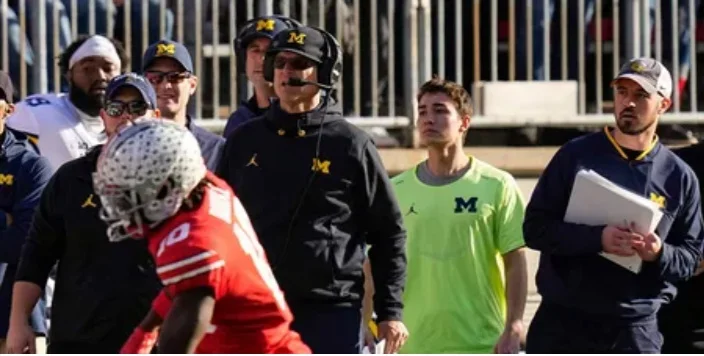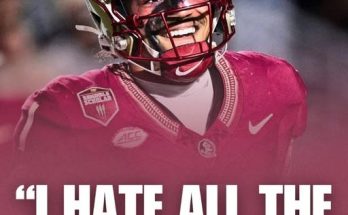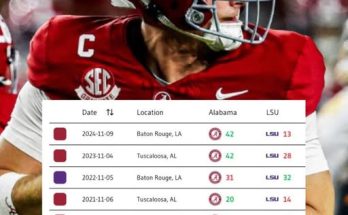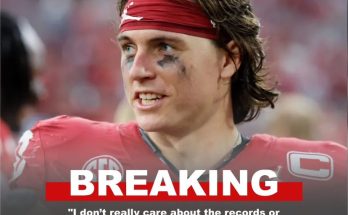Any Connection Between Ohio State and the Stallions Scandal Is Destroyed by TTUN’s Explosive NOA Response
In the world of college football, the rivalry between Ohio State and the University of Michigan, colloquially referred to as “The Game,” is often considered one of the most intense, high-stakes rivalries in the sports world. This rivalry has spanned decades, filled with memorable games, passionate fanbases, and an unrelenting desire to one-up each other on the field. However, recent off-field drama has taken this rivalry to new heights, with the emergence of the Stallions scandal, which threatened to pull Ohio State into a controversy with its biggest rival, Michigan.
This scandal, involving Michigan’s alleged improper scouting practices, rocked the college football community, and as details about the situation began to unfold, Ohio State’s name was inevitably dragged into the conversation. But despite the swirling rumors and questions, Michigan’s swift and aggressive response, in the form of a bombshell Notice of Allegations (NOA), has decisively severed any potential ties between Ohio State and the ongoing scandal.
The Stallions Scandal: A Quick Overview
Before diving into the intricacies of Michigan’s NOA response, it’s essential to understand the basics of the Stallions scandal itself. The issue began when allegations surfaced against Michigan’s football program involving illegal scouting practices. At the center of the controversy was Connor Stallions, a low-level assistant at Michigan, who allegedly orchestrated the use of sophisticated methods to gain access to opponents’ play calls, game strategies, and other sensitive information. This scandal, which the media quickly dubbed the “Stallions Scandal,” suggested that Michigan was engaging in an elaborate, underhanded scheme to gain a competitive advantage over their opponents, including Ohio State.
While the allegations initially seemed to center solely on Michigan, some had questioned whether any outside programs or schools, including Ohio State, might have had knowledge of or involvement in these illegal activities. Given the longstanding and fierce rivalry between Ohio State and Michigan, this connection seemed all too easy to make in the minds of fans, journalists, and some of the more conspiratorial members of the sports media. Accusations and rumors circulated quickly, suggesting that perhaps the Stallions scandal was more widespread than originally thought, and the Buckeyes could be implicated in some way.
However, despite the rumors, there was no concrete evidence to suggest that Ohio State had played a role in the scandal. In fact, as the investigation into the situation continued, it became clear that the relationship between Ohio State and Michigan in this matter was purely speculative.
Michigan’s Response: An Explosive NOA
In the face of the mounting scandal, Michigan’s athletic department, alongside its legal team, was under significant pressure to respond quickly and decisively. The fallout from the Stallions Scandal was threatening not only the reputation of their football program but also the standing of the entire school in the eyes of college football fans and officials. Michigan could not afford to let the situation spiral further out of control.
In an effort to address the allegations and clear its name, Michigan released a comprehensive response in the form of a Notice of Allegations (NOA). This document, which is used by the NCAA to formally outline allegations of violations committed by a program, was a carefully crafted piece of legal and public relations strategy. The NOA was designed to refute the most damaging claims, clarify the details of the situation, and emphasize Michigan’s commitment to upholding the integrity of college football.
One of the most significant elements of the NOA response was Michigan’s adamant denial of any wrongdoing beyond the actions of Connor Stallions. In particular, the university vehemently rejected any notion that Ohio State, or any other school, had been involved in the illicit activities. Michigan’s legal team took great care to address the swirling rumors and quickly destroyed any connection between Ohio State and the scandal.
By providing a detailed timeline of events and presenting evidence that clearly indicated the solitary involvement of Stallions, Michigan positioned itself as the victim of an isolated incident, rather than a program-wide conspiracy. The NOA further emphasized that the coaching staff, including head coach Jim Harbaugh, was not involved in the wrongdoing, which was critical for preserving the integrity of Michigan’s program.
The NOA also clarified Michigan’s full cooperation with the NCAA’s investigation and its commitment to ensuring transparency throughout the process. In short, Michigan’s response was a well-executed defense designed to exonerate itself, lay blame squarely at the feet of Stallions, and, perhaps most importantly, disassociate Ohio State from the scandal.
The Impact on Ohio State’s Reputation
As Michigan’s NOA response was released, Ohio State fans and college football observers breathed a collective sigh of relief. With the explicit removal of any ties to the Stallions scandal in the document, Ohio State’s name was cleared in the eyes of the NCAA, the media, and the public. The accusations of wrongdoing involving Ohio State had been unfounded, and the NOA made it clear that Michigan had no evidence of any involvement by its rival in the scandal.
The response also had the added effect of protecting Ohio State’s reputation as a program that adheres to the highest standards of fairness and integrity. The Buckeyes, who have always been proud of their football program’s reputation for discipline and professionalism, were eager to distance themselves from any controversy that might tarnish their legacy. Michigan’s careful legal maneuvering in issuing the NOA ensured that Ohio State’s name was fully exonerated, and any lingering questions about the Buckeyes’ possible involvement in the scandal were definitively put to rest.
Moreover, Ohio State was able to focus its attention back on the field, where the Buckeyes had their own goals in mind: winning Big Ten championships and competing for a spot in the College Football Playoff. The last thing Ohio State wanted was to be dragged into a scandal that would overshadow the team’s efforts to succeed on the gridiron. Thanks to Michigan’s thorough and forceful response, that fear was alleviated.
The Fallout: Repercussions for Michigan’s Program
While Ohio State successfully avoided any association with the scandal, the same cannot be said for Michigan. The fallout from the Stallions scandal and the subsequent NOA response was significant for the Wolverines, who found themselves under intense scrutiny. While Michigan’s legal team had carefully crafted the NOA to distance the university from further damage, the scandal still cast a long shadow over the program.
Despite Michigan’s attempts to clear its name, the public perception of the program had been irreparably damaged. Even with the university’s cooperative stance with the NCAA and its assertion that only one individual was responsible for the illegal activities, many fans, analysts, and rival schools were not willing to let the matter go so easily. The Stallions scandal had placed a tarnish on what had otherwise been a highly successful period for Michigan football.
Additionally, Michigan’s NOA response raised further questions about the oversight of the football program. How did Stallions, a low-level staffer, manage to operate such a sophisticated network of illegal scouting without the knowledge of higher-ups? This lingering question became a central focus for both Michigan’s supporters and detractors, who were eager to find out whether there were deeper issues within the program’s structure.
The scandal was compounded by the fact that Michigan had enjoyed a period of dominance in the Big Ten, including multiple victories over Ohio State in recent years. For many Ohio State fans and college football analysts, the timing of the scandal raised suspicions about the legitimacy of Michigan’s recent success. Even though the NOA response placed full blame on Stallions, the question remained: was the program itself fully clean?
Ohio State’s Role Moving Forward
For Ohio State, the aftermath of the scandal presents an opportunity to solidify its position as one of the preeminent programs in college football. With the Stallions scandal no longer a distraction, the Buckeyes can focus on their own aspirations for championships and continue their quest to dominate the Big Ten.
The rivalry between Ohio State and Michigan is one of the cornerstones of college football, and the Buckeyes have historically had the upper hand in recent years. The addition of a major scandal involving Michigan only fuels the competitive fire between the two teams. With Michigan’s reputation somewhat tarnished and Ohio State fully exonerated, the stage is set for a renewed and even more intense rivalry, one in which the Buckeyes are poised to benefit from their newfound sense of clarity.
The outcome of the Stallions scandal, while unfortunate for Michigan, highlights the resilience of Ohio State’s football program, which has successfully navigated a potentially damaging situation without any blemishes on its own record.
Conclusion
In the end, Michigan’s explosive NOA response has effectively severed any connection between Ohio State and the Stallions scandal, clearing the Buckeyes of any wrongdoing or association with the controversy. While Michigan is left to deal with the fallout of the scandal and the damage to its own reputation, Ohio State can now move forward with a sense of relief. The Buckeyes have successfully weathered the storm, and as the rivalry between the two teams continues to heat up, the focus will return to the field, where Ohio State remains one of the premier programs in college football.



